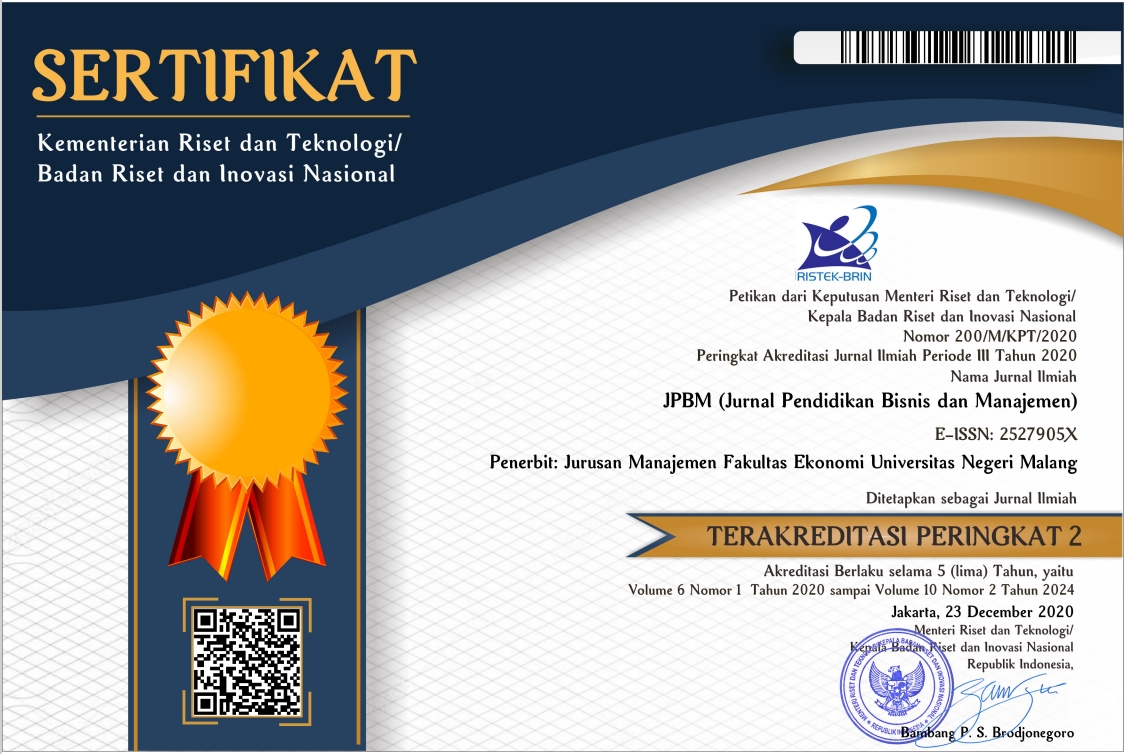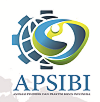Blended Synchronous Learning and Students’ Critical Thinking Ability: Lesson from Covid-19
Abstract
The Covid-19 pandemic has been a primary issue, and the educational sector has responded to this issue by providing various alternative learning activities to provide the indifference essence as in the normal situation. In more specific, this study aims to examine the implementation of blended synchronous learning-based and its impact on students’ critical thinking in economics. This study applied mixed methods, quasi-experimentally by using non-equivalent control group design research to determine the different changes during the experimental period. The findings of the study indicate that in addition to diminishing tedium in the classroom, blended synchronous learning outraces the conventional learning and can explain an increase in critical thinking abilities of students. Additionally, this study demonstrates the remarkable different between treated students and control group in the term of critical thinking from the perspective of SOLO taxonomy.
Keywords—blended synchronous learning, critical thinking ability, blended learning, learning management system
Full Text:
PDFReferences
Akib, E., & Muhsin, M. A. (2020). Critical thinking in cognitive domain: Exploring assessment of English teaching at pandemic period of covid-19. JEES (Journal of English Educators Society), 5(2), 178-184.
Akkoyunlu, B., & Soylu, M. Y. (2008). A study of student’s perceptions in a blended learning environment based on different learning styles. Journal of Educational Technology & Society, 11(1), 183-193.
Almaiah, M. A., Al-Khasawneh, A., & Althunibat, A. (2020). Exploring the critical challenges and factors influencing the E-learning system usage during Covid-19 pandemic. Education and Information Technologies, 25, 5261-5280.
Ariawan, S., & Malang, S. T. I. P. A. K. (2020). Building critical thinking in Covid-19 pandemic era: Impossible or I am possible?. International Research Journal on Advanced Science Hub, 2(6), 127-130.
Asyari, M., Al Muhdhar, M. H. I., & Susilo, H. (2016). Improving critical thinking skills through the integration of problem based learning and group investigation. International Journal for Lesson and Learning Studies, 5(1), 36-44
Bao, W. (2020). COVID‐19 and online teaching in higher education: A case study of Peking University. Human Behavior and Emerging Technologies, 2(2), 113-115.
Borba, M. C., Askar, P., Engelbrecht, J., Gadanidis, G., Llinares, S., & Aguilar, M. S. (2016). Blended learning, e-learning and mobile learning in mathematics education. ZDM, 48(5), 589-610.
Ceylan, V. K., & Kesici, A. E. (2017). Effect of blended learning to academic achievement. Journal of Human Sciences, 14(1), 308-320.
Cheng, Y. Y., Wang, W. C., Wu, J. J., & Huang, C. H. (1996). A preliminary report on the construction of the Critical Thinking Scale (CTS). Psychological Testing, 43, 213–226.
Creswell, J. W., & Clark, V. L. P. (2017). Designing and conducting mixed methods research. Sage publications.
D’Alessio, F. A., Avolio, B. E., & Charles, V. (2019). Studying the impact of critical thinking on the academic performance of executive MBA students. Thinking Skills and Creativity, 31, 275-283.
Desai, M. S., Berger, B. D., & Higgs, R. (2016). Critical thinking skills for business school graduates as demanded by employers: a strategic perspective and recommendations. Academy of Educational Leadership Journal, 20(1), 10-31.
Dziuban, C., Graham, C. R., Moskal, P. D., Norberg, A., & Sicilia, N. (2018). Blended learning: the new normal and emerging technologies. International Journal of Educational Technology in Higher Education, 15(1), 1-16.
Harahap, F., Nasution, N. E. A., & Manurung, B. (2019). The effect of blended learning on student’s learning achievement and science process skills in plant tissue culture course. International Journal of Instruction, 12(1), 521-538.
Kitsantas, A., Baylor, A. L., & Hiller, S. E. (2019). Intelligent technologies to optimize performance: Augmenting cognitive capacity and supporting self-regulation of critical thinking skills in decision-making. Cognitive Systems Research, 58, 387-397.
Mankiw, N. G. (2020). Principles of economics. Cengage Learning.
Maryam, I. (2018). Pengaruh blended learning berbantuan microsoft mathematic terhadap kemampuan berpikir kreatif. Jurnal Pendidikan Surya Edukasi (JPSE), 4(2), 23-34.
Morningstar, M. E., Zagona, A. L., Uyanik, H., Xie, J., & Mahal, S. (2017). Implementing college and career readiness: Critical dimensions for youth with severe disabilities. Research and Practice for Persons with Severe Disabilities, 42(3), 187-204.
Nadeak, B., Juwita, C. P., Sormin, E., & Naibaho, L. (2020). Hubungan kemampuan berpikir kritis mahasiswa dengan penggunaan media sosial terhadap capaian pembelajaran pada masa pandemi Covid-19. Jurnal Konseling dan Pendidikan, 8(2), 98-104.
Narmaditya, B. S., Wulandari, D., & Sakarji, S. R. B. (2018). Does problem-based learning improve critical thinking skill?. Cakrawala Pendidikan, 37(3), 378-388.
Nortvig, A. M., Petersen, A. K., Helsinghof, H., & Brænder, B. (2020). Digital expansions of physical learning spaces in practice-based subjects-blended learning in Art and Craft & Design in teacher education. Computers & Education, 159, 104020.
Shavelson, R. J., Zlatkin-Troitschanskaia, O., Beck, K., Schmidt, S., & Marino, J. P. (2019). Assessment of university students’ critical thinking: Next generation performance assessment. International Journal of Testing, 19(4), 337-362.
Siburian, J., Corebima, A. D., & Saptasari, M. (2019). The correlation between critical and creative thinking skills on cognitive learning results. Eurasian Journal of Educational Research, 19(81), 99-114.
Siron, Y., Wibowo, A., & Narmaditya, B. S. (2020). Factors affecting the adoption of e-learning in Indonesia: Lesson from Covid-19. Journal of Technology and Science Education, 10(2), 282-295.
Smith, G. F. (2003). Beyond critical thinking and decision making: Teaching business students how to think. Journal of Management Education, 27(1), 24-51.
Tharakan, J. (2020). Using educational technology to enhance creative and critical thinking skills through open ended design projects. Journal of Engineering Education Transformations, 33, 225-232.
Toquero, C. M. (2020). Challenges and opportunities for higher education amid the Covid-19 pandemic: the Philippine context. Pedagogical Research, 5(4).
Van Laar, E., Van Deursen, A. J., Van Dijk, J. A., & De Haan, J. (2017). The relation between 21st-century skills and digital skills: A systematic literature review. Computers in human behavior, 72, 577-588.
Wechsler, S. M., Saiz, C., Rivas, S. F., Vendramini, C. M. M., Almeida, L. S., Mundim, M. C., & Franco, A. (2018). Creative and critical thinking: Independent or overlapping components?. Thinking Skills and Creativity, 27, 114-122.
Refbacks
- There are currently no refbacks.
JPBM (Jurnal Pendidikan dan Bisnis Manajemen) is licensed under a Creative Commons Attribution-NonCommercial-ShareAlike 4.0 International License.
JPBM (Jurnal Pendidikan dan Bisnis Manajemen) is abstracted and indexed in :
















